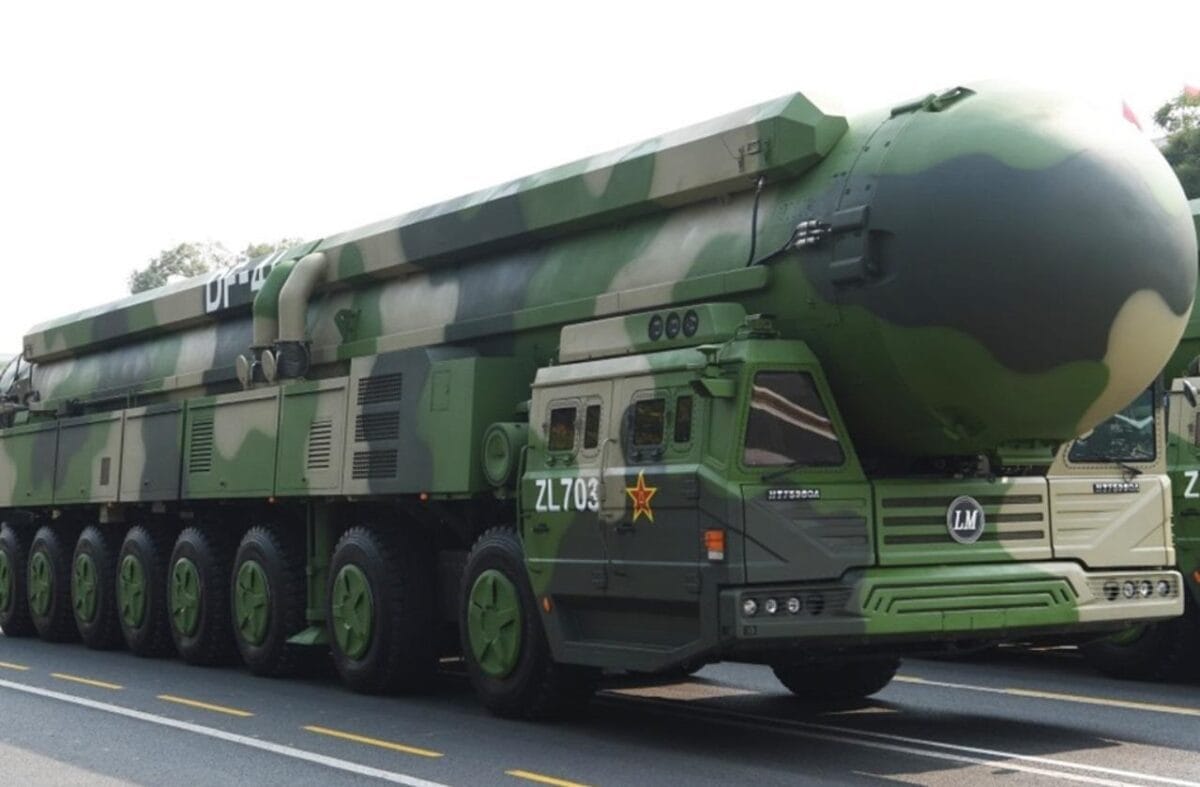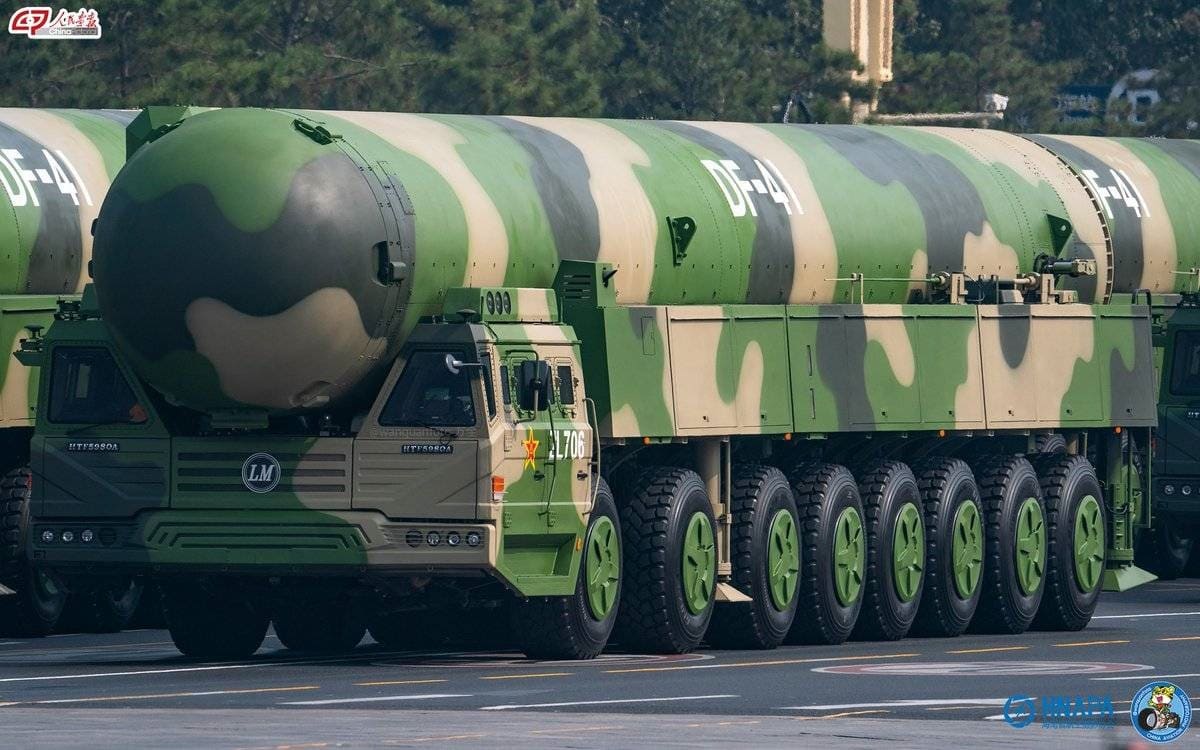The head of U.S. Strategic Command Admiral Charles Richard has been describing China’s nuclear weapons expansion as a “strategic breakout.” He used the term at an event I recently hosted at Hudson Institute, where he said each Chinese intercontinental ballistic missile (ICBM) could carry “a lot” of warheads. He began using the phrase strategic breakout after his command seemed to confirm the discoveries of civilian researchers who discovered two large fields of at least 230 nuclear ICBM silos in north-central China. Since then, researchers have discovered a third site.
The public discoveries put to rest a dispute among analysts over whether China is significantly expanding its nuclear arsenal. Indeed, it confirms what Pentagon officials have been warning. Recall, in Spring of 2019 Defense Intelligence Agency Director Lt. Gen. Robert P. Ashley, Jr., said, “China is likely to at least double the size of its nuclear stockpile in the course of implementing the most rapid expansion and diversification of its nuclear arsenal in China’s history.” He went on to allude to the distinct possibility that China is conducting explosive nuclear testing.
And, in 2020 Austin Long, Vice Deputy Director for Strategic Stability at the Joint Staff warned, “The nuclear arsenal of the People’s Republic of China and its plans to use it are in the middle of an unprecedented shift.” Before this unprecedented shift, Long reminded, the Chinese nuclear posture matched its declared policy of “no-first-use”.
And Admiral Richard made some waves when he penned in February 2021, “China’s nuclear weapons stockpile is expected to double (if not triple or quadruple) over the next decade.”
So for a couple of years, those with greater insight into China’s nuclear activities, have been painting a foreboding, though accurate, picture: the PRC is making a dramatic shift in the scope of its nuclear arsenal, swelling it in numbers, and proving its reliability by explosively testing.
But it’s not just about numbers and reliability. The PRC is adding types of delivery systems and is demonstrating its ability to quickly adapt, and change direction based on the decisions of its political leadership. The strategic breakout that Admiral Richard is talking about is the result of the PRC decision to change strategies. After patiently expanding its military conventionally and gaining power and influence economically and diplomatically it has chosen to move away from maintaining a nuclear force meant for purely defensive purposes; its nuclear force is no longer designed to defend itself by guaranteeing it can withstand and retaliate a first nuclear strike. PRC leadership has opted to build and prepare for an entirely different kind of nuclear force—one for coercive purposes to carry out its revanchist aims.
This is why thoughtful technical analysis about China’s siloed ICBMs, while enlightening, only provides an incomplete picture of the challenge, and if not considered in a broader context, can lead to dangerously wrong assessments of the threat to US security. For example, some analysts, while agreeing the PRC’s lurch forward in nuclear expansion is concerning, find comfort in the technical machinations, noting that the PRC is merely seeking to match the United States’ nuclear force, something we should all expect and perhaps accept as reasonable for a rising power looking to match the United States across all areas of military power.
After all, isn’t further entrenching the United States into a mutually vulnerable dynamic with yet another adversary nation stabilizing? But this conclusion about stability assumes a symmetry in PRC and American goals, in the value each nation places on the geopolitical stakes and therefore the degree of political will for taking on what would be a significant cost. But we already know there is not a symmetry between the two nations in maintaining decades-old status between them and in respecting the sovereignty and autonomy of smaller nations.
The PRC’s departure from decades-long minimum deterrence and a purported no first use policy, is occurring during an acceleration of rapid military expansion, threats against free and autonomous peoples such as its squashing of democratic institutions in Hong Kong, and now provocations and threats against free and democratic Taiwan.
If the PRC decides that seizing democratic Taiwan is worth a showdown with the United States, then China’s nuclear weapons will undoubtedly be used in a coercive way to threaten the United States and our allies from intervening, and then from escalating conventionally to terminate the conflict on terms favorable to the United States. This scenario was depicted when the CCP aired a video in which it threatened to use nuclear weapons first against Japan should it attempt to defend Taiwan. Recall, in 2020 the PRC released a video of a simulation of an attack with nuclear-capable bombers against the U.S. territory of Guam.
From the perspective of an American committed to the U.S. maintaining national objectives: a free and open Indo-Pacific, a secure democratic Taiwan, and credible nuclear assurances to our regional allies, China’s dramatic departure away from a defensive nuclear strategy is destabilizing.
There is a clash of national objectives and an uncertainty about national wills in defending those objectives. And Beijing is seeking to buttress its capabilities to carry out its objectives and is flexing serious muscle to communicate its will. Are we?
Rumors swirl about the Biden administration’s forthcoming nuclear policy guidance. During the presidential campaign, Biden was committed to adopting a policy of No First Use, though allies have expressed objections to doing so. And, there is some Congressional pressure to delay critical nuclear modernization efforts, despite studies that conclude doing so would cause the United States to fail to meet the deterrence requirements that the previous administrations agreed were necessary; and it is good to keep in mind that the threat environment has deteriorated since those acquisition strategies from Democrat and Republican administrations were conceived.

DF-41 ICBM. Image: Chinese Internet.
The United States must do more, not less, to demonstrate that US diplomats’ verbal commitments to US security interests are supported by our ability and will to defend them. It is imperative we maintain a broad ambiguous nuclear declaratory policy, fully fund the nuclear weapons modernization project, and adapt in any way necessary including by adding weapons. Anything the Biden administration is considering to constrain U.S. options, rather than grow them, risks tempting Chinese aggression.
Rebeccah L. Heinrichs is a senior fellow at Hudson Institute specializing in US national defense policy with a focus on strategic deterrence.

